You may not find this terribly rewarding unless you're included here, so this is a good time for casual and random browsers to turn back before they get too caught up in the sweep and majesty of the proceedings and can't let go.

Just time for a little breakfast and chat with our friendly breakfasteers, then we're off . . .

. . . down to visit the famous Villa d'Este, one of the main reasons we've come all this way.

The capacious Piazza Trento, facing . . .

. . . the Chiesa di Santa Maria Maggiore and just beyond it, what was once the back door to the Villa d'Este, but is now the front door.
The Villa d'Este is a 16th century creation of a palatial villa and an elaborate Renaissance garden with masses of fountains extending something like 11 acres down a terraced hillside. It was the brainchild of Cardinal Ippolito d'Este (1509-1572), an apparently accomplished administrator and diplomat who, at his peak, was considered the wealthiest cardinal in the stable.

Past the ticket booth, we're pacing across the courtyard, built over the cloisters of the former convent of the Benedictine order, which had been built in the 9th century on the site of an old Roman villa.
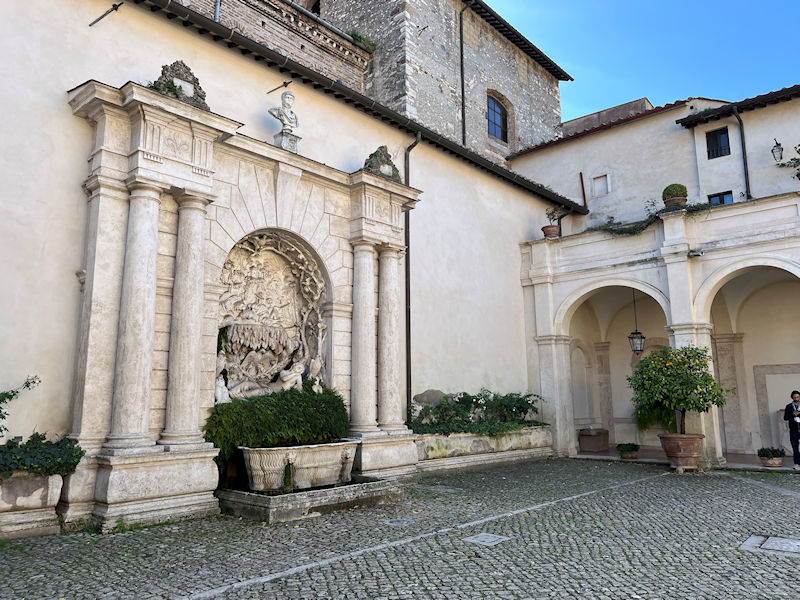
That's the Fountain of Venus, created by Raffaelo Sangallo in 1568–69, crowned by a 4th-century marble bust of the Emperor Constantine. The reclining or sleeping 'Venus' just above the foliage is a Roman original from the AD 4th or 5th centuries.
Though she's widely referred to as Venus, she's apparently intended to represent a resident nymph, or genius loci.

Don't pay attention to the sleeping lady, she's probably faking it for attention. Cardinal Ippolito II d'Este was the second son in the illustrious Este family who'd been lords of Ferrara since the 1390s. His father was Alfonso I, the 3rd Duke of Ferrara, his mother was Lucrezia Borgia, and his brother was Ercole II, the 4th Duke after 1534; as the second son, Ippolito was slated for a life in the church.
As such, he was appointed Archbishop of Milan at the age of 10 (the same year in which his mother died), and was sent at 27 as an adviser to the French Court, where Francis I promoted him to his Private Council in 1540. There he served well, evidently, and at the age of 30 Francis got Pope Paul III to make Ippolito a cardinal. Amid his diplomatic duties, he was renowned as a patron of the arts, supporting Benevenuto Cellini, the musician Palestrina, and the wayward poet Torquato Tasso, amongst others. The next French king, Henri II, got him sent back to Rome as his representative, where Este flourished in that social and political milieu, and was soon proposing himself in elections for new popes (he gave it a shot five times, but seems have been too blatantly rich and proud of it for the electors).

As a consolation for being passed over on the Big Tiara, the College of Cardinals appointed him lifetime Governor of Tivoli in 1549, which suited him as an avid collector of antiquities, for Tivoli had become the focus of productive excavations of Roman remains, especially Hadrian's Villa just below the town. His official residence was to be this ancient Benedictine convent, which he soon concluded was inadequate for an extravagantly rich patron of the arts with a large entourage, and thus a new project was born. He recruited Pirro Ligorio, a scholar who'd studied the Villa Adriana, to set about planning a new villa and garden that would astound everybody.

The frieze above, representing arts and crafts of the Tivoli region, was added in 1925 by Emilio Notte, said to have been using real craftsmen, etc., as the model for each of the panels.
Ippolito was involved in various diplomatic missions for the papacy and the French King Henri II, but came back here in 1555 only to be accused of simony by Pope Paul IV Carafa and exiled. When he got his governship back in 1559, construction here got underway. Much of the land had been acquired, but for the next 10 years his agents pushed through the demolition of buildings and roads and provoked 12 lawsuits against him; undeterred, terracing for the gardens continued through the mid-1560s, marble and statuary was scavenged off the Hadrian's Villa ruins, and arrangements were made to divert Aniene river water up to feed the enormous number of fountains, cascades, pools and water jets planned for the new gardens.

In the small private chapel, this is a copy of a famous painting, the Madonna della Ghiara, painted by Giovanni Bianchi in 1573 for the Este property in Reggio Emilia. It was the occasion of a miracle in 1596 and became a pilgrimage destination, for which the Basilica della Madonna della Ghiara was built on the site in Reggio Emilia, and this copy was probably commissioned by Alessandro d'Este after he succeeded as Governor of Tivoli in 1605.

Most of the other frescos in the chapel, all having to do with the life of the Madonna, were painted by Federico Zuccari and assistants between 1568 and 1572.

The director of the worker teams through the 1560s was the court architect of the Este family, Alberto Galvani of Ferrara, and teams of painters and stucco workers, as well as sculptors, ceramists, and mosaic artists, were supervised by Zuccari, Girolamo Muziano, Livio Agresti of Forlì, and others throughout 1567 to 1572.
Cardinal Ippolito died in late 1572 and the villa and gardens passed to his nephew, Cardinal Luigi d'Este, who tried to carry on the expensive work. When he died in 1586, the villa was taken over by the 'Cardinal Deacons of the Sacred College', who did nothing for it, but it was then returned to the Este family in 1599.

Duke Alfonso II had died in 1597 with no male heirs, and leadership of the family passed to Cesare d'Este, illegitimate son of a cadet branch -- Pope Clement VIII claimed that given the heir's illegitimacy, the family seat of Ferrara must revert to the Papal States' direct rule, and he drove the Estes out of town by force of arms. Cesare retained the Dukedoms of Modena and Reggio, however, and his brother, Cardinal Alessandro d'Este (1568-1624), took over the renovations and improvements to the Tivoli estate, and after his death the Dukes of Modena carried on with it until, after 1695, they couldn't afford the expenses anymore.

The villa thereafter suffered a long decline; after 1751 the furnishings were sent to Modena and the antique sculpture in the gardens was gradually sold off. It passed by marriage to the Habsburgs in 1796, who neglected it, and was twice occupied by French soldiers during the Napoleonic years, which never ended well.
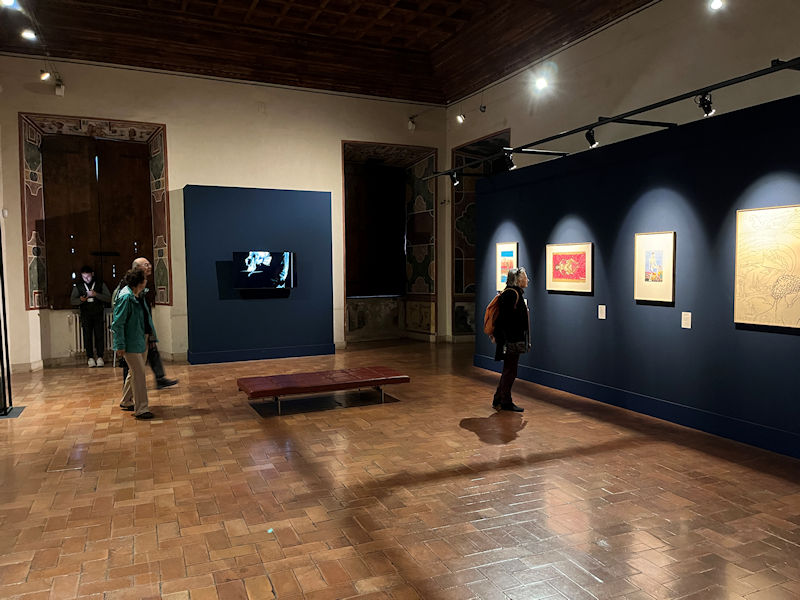
From 1850 to 1896, however, Cardinal Gustav von Hohenlohe owned it and set out renovating it to capture the romantic zeitgeist, and it could once again host artists, writers, and musicians (including Franz Liszt on several long and musically productive visits).
This room hosts an exhibition of the works of Yves Klein (1928-1962), Piero Manzoni (1933-1963), and Francesco Lo Savio (1935-1963) -- 'A new world requires a new man'.
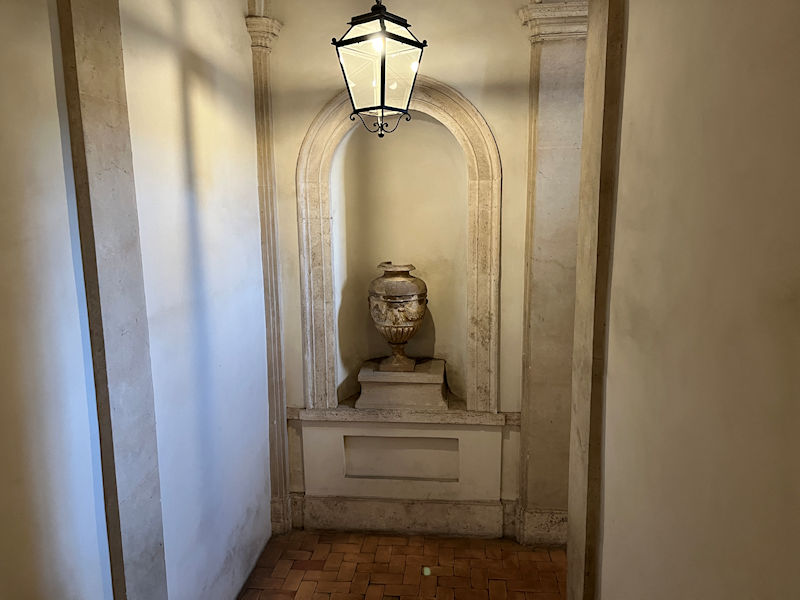
The Italian government assumed ownership after World War I and began a serious restoration effort in 1922. Bomb damage in 1944 set matters back, but campaigns of restoration and protection have continued successfully, aided by the growing increase in the villa's fame as a premier tourist destination.

We're wandering lonely as a cloud at the moment, but confident that something will turn up soon. We do note, however, that this long corridor is punctuated with a number of rustic fountains.
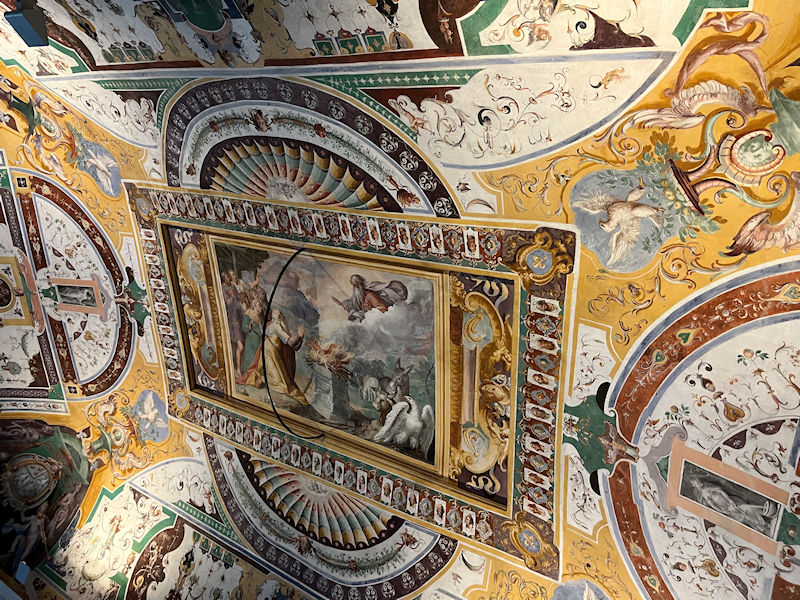
The ceiling centrepiece in the Hall of Noah (that's Noah bargaining with God, or something)

The Noah room is dated to 1571 and is attributed to Girolamo Muziano, who was famous for similar scenes of Venetian landscapes.

The 'Villa d'Este, Tivoli' is, by the way, a UNESCO World Heritage cultural property (#1025), inscribed in 2001.

Landscapes

Every inch of space, etc.

The Triumph of Apollo, in the Second Tiburtine Hall, and . . .
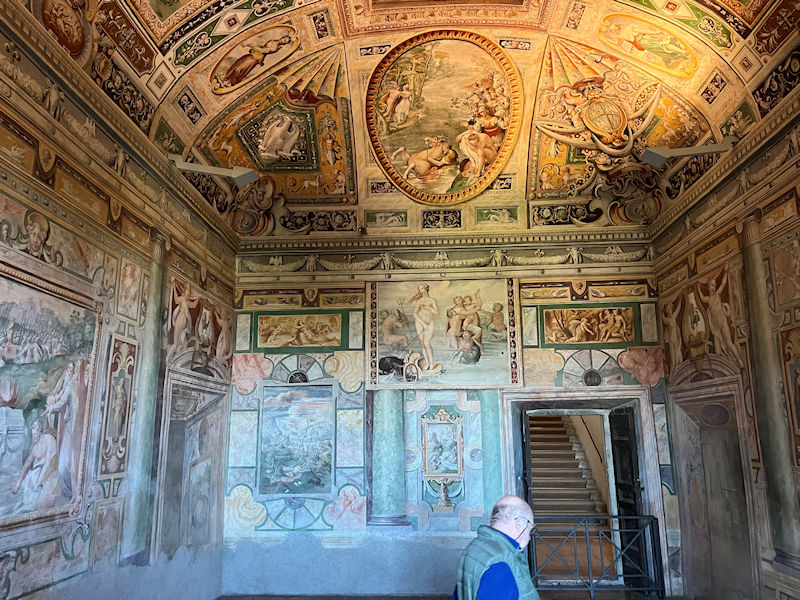
. . . it looks like Venus gets a few moments in the sun as well.

The Tiber, Aniene, and Erculaneo Rivers

That is the 'Adoration of Mater Matuta with her young son Portunus', in the Second Tiburtine Room. As part of the mythical origins of Tivoli, there is the story of Ino, who was saved from Juno's wrath by Venus and Neptune and renamed Leucothea ('White Goddess', a Greek sea goddess, protector of sailors). 'Subsequently, Ino-Leucothea landed in Italy and firstly became Mater Matuta (and her son Portunus, the god of ports) and then a Sibyl, making her dwelling in the woods near the city of Tivoli' (from the info plaque).
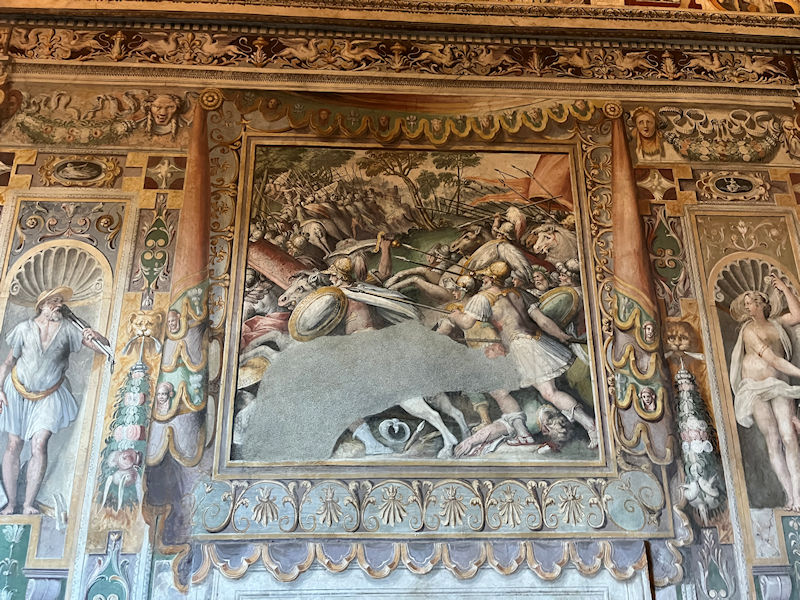
The battle of the brothers Tiburtus, Coras, and Catillus against the Sicelians ('ethnic cleansing' for a site for their new city)

In the First Tiburtine Hall, this is part of a story of Hercules, protector of Tivoli and the Estes family. In his 10th labor, he steals Geryon's oxen and is ambushed, but Jupiter comes to his aid by raining down stones upon the attackers. The picture is thus called 'Hercules Saxanus', 'of the rocks'.

(-- Incoming!)
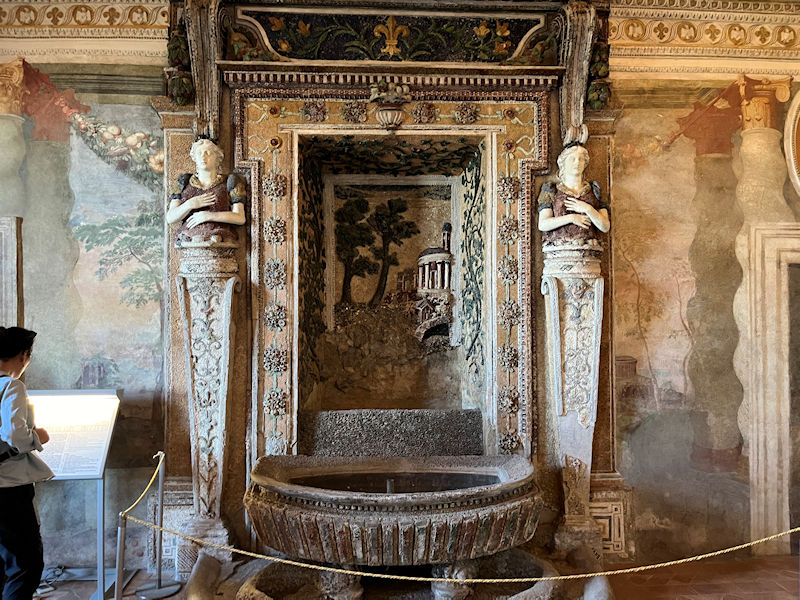
The rustic fountain in the Salon of the Fountain (1568)
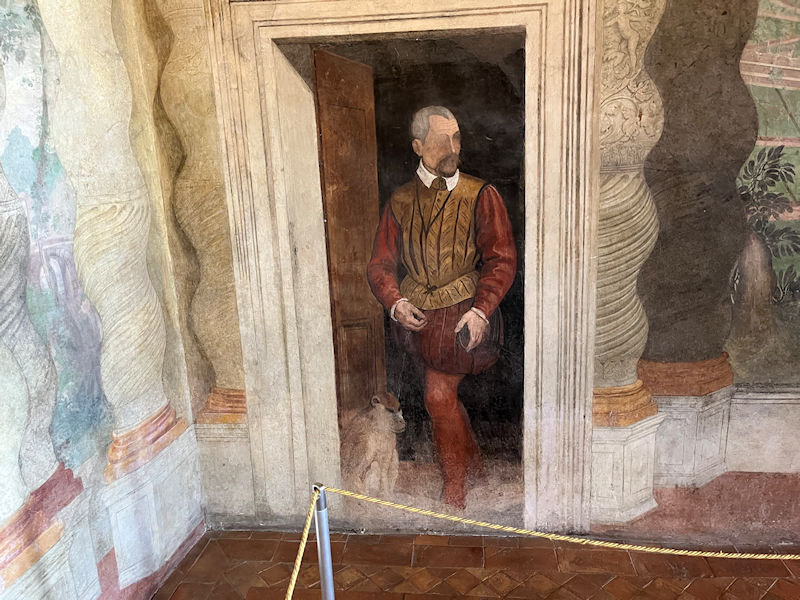
A sneaky time-traveling 16th century guy and his monkey

The Tripod Fountain, on our way down to the gardens

The long terrace just above the gardens, called the 'Vialone'


Is that someone hiding over there? Oh.

The Vialone terrace, end to end, is more than 100m long.
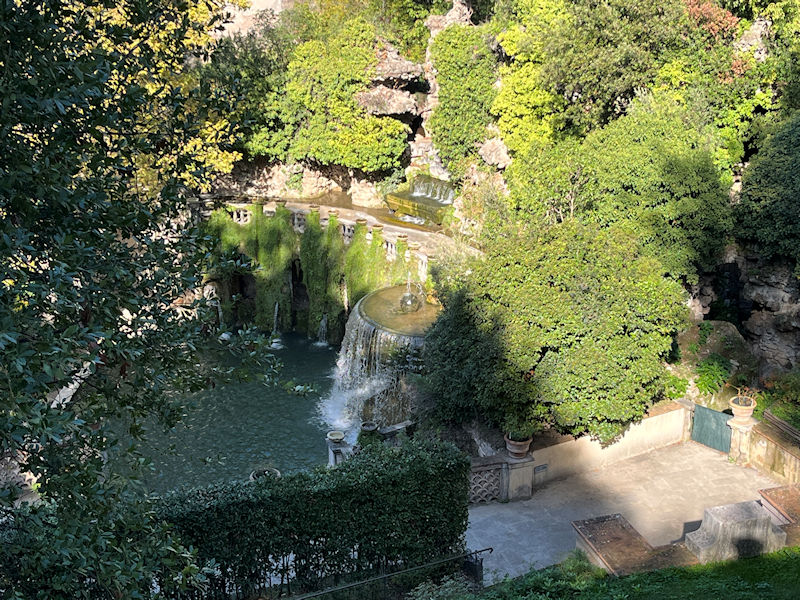
The Oval Fountain just below us

The double loggia, by Pirro Ligorio -- two staircases leading to the ceremonial rooms surmounted by a terrace/balcony off the Cardinal's private chambers.

The Tripod Fountain

By one count, there are '51 fountains and nymphaeums, 398 spouts, 364 water jets, 64 waterfalls, and 220 basins, fed by 875 metres of canals, channels and cascades, and all working entirely by the force of gravity, without pumps'.
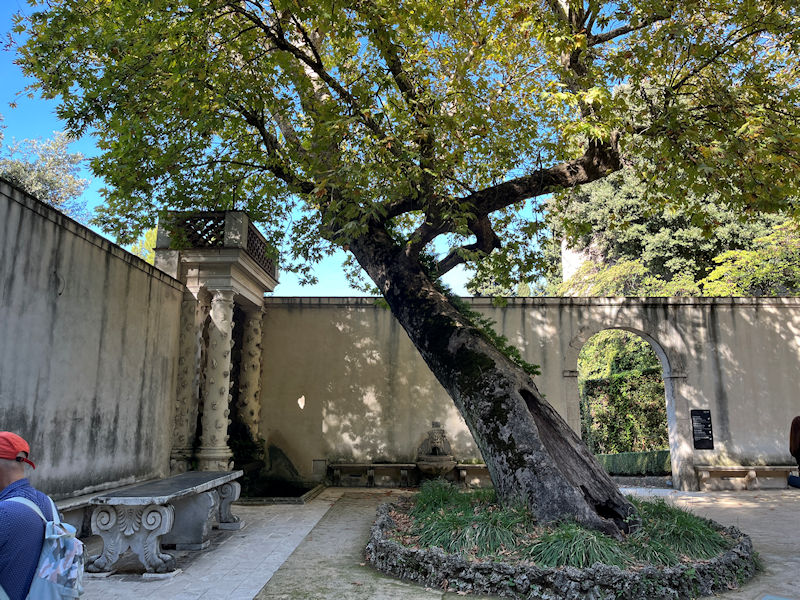

The One Hundred Fountains across the width of the gardens

The Oval Fountain

The Oval Fountain and . . .

. . . on the right, a 'cool nymphaeum' honoring water goddesses, designed by Ligorio, 1565-1568, 'used as a meeting place on summer days'.


That's the Fountain of the Organ, which . . .

. . . inhabits the 'Water Castle' and evidently has a real organ in it -- supposedly there's a keyboard in there in the centre (guidebooks show the keyboard and pipes when that little door is open).

Work began on the masonry in 1566, led by a French fountain specialist, and the clever mechanism of the water organ was installed in 1571. The Estes eagle is a grace note.

At the moment we're standing in front of the Organ Fountain on top of the Fountain of Neptune, looking out at the Fish Ponds.

Sploosh!

The villa and the church's bell tower behind

Manicured shrubs and lawns, good work!

The Neptune Fountain from below

The Fish Ponds with a visitor
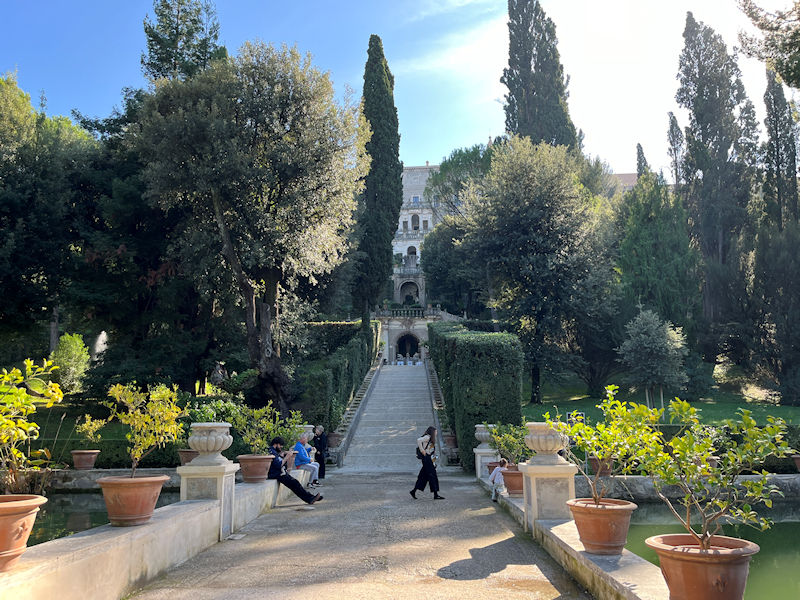
The central avenue through the gardens -- in its heyday, the Villa's main entrance was behind us here, so that honored visitors could appreciate all this spectacle as they wore themselves out on the uphills.

The upward facing shell-shaped fountain just above the two archways is the 'Fountain of the Bicchierone' (a cup or chalice), one of two fountains created for the villa by Gian Lorenzo Bernini. It was made between 1660 and 1661 on a commission from Cardinal Rinaldo I d'Este.

The Fish Ponds

The Cypress Rotunda

One of the 'Mette Fountains' (no explanation provided)

The countryside from the gardens
We were wondering what those rows of little post-things poking out of the field were. We found out a few days later.

The southwestern wall of the gardens

The Fish Ponds and Fountain of the Organ

The Fountain of the Owl

-- So where's the owl?

The Fountain of Persephone

The courtyard of the Owl Fountain, from the Persephone

The boat with an obelisk mast, symbolizing the Tiburtina island in the Tiber, below the statue of Rome Triumphant. That's all part of the Rometta Fountain.

The 'Cenacolo', or Gran Loggia, at the end of the Vialone terrace.
Next up: A bit more of the amazing Villa d'Este, then the search for the Duomo
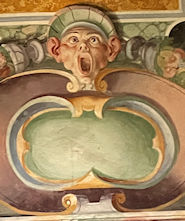 Dwight Peck's personal website
Dwight Peck's personal website





































































































